Many years ago, the watchword in the gentleman’s clubs was, “What the world needs is a good five-cent cigar.” Today, in the bike hangouts, they’re saying, “What the world needs is a good touring cruiser for $8,500.” If that’s the case, Kawasaki has certainly delivered the goods with its new Vulcan 900 Classic LT; with its windscreen, saddlebags, studded seat and backrest it’s the touring version of Kawi’s new-for-2006 903cc V-twin cruiser. The 900’s predecessor was the Vulcan 800, which was powered by an 805cc liquid-cooled V-twin, and transferred power to the rear wheel by chain final drive. It put a lot of people on two wheels, and you can bet that its successor-which is a completely new bike-will do likewise.
For 2006 this new midsized Vulcan gets a double-cradle frame with a large-diameter box-section backbone. The single shock is hidden to give the impression that the hindquarters are a hardtail. The engine’s dimensions are not just a slight overbore as is often the case, but have been completely reworked to change the power characteristics. The Vulcan 800 had bore-and-stroke figures of 88.0 x 66.2mm, a big bore and short stroke that resulted in an engine that liked to rev. For 2006 the new figures are 68.0 x 74.2mm, which is a total tilt in the strokier, torquier direction which is where cruiser riders like ’em. At 903cc the new Vulcan displaces 98cc more than its predecessor, and Kawasaki claims it produces 61 lb-ft of torque at the crank at 3,700 rpm. It has also grown in length; its 64.8-inch wheelbase is more than an inch longer than that of a Harley-Davidson Road King.
The change from chain to belt final drive is a positive, as a belt is lighter, quieter and essentially maintenance free-other than a very occasional adjustment. Otherwise, the Vulcan 900 retains all the good stuff such as the liquid-cooled V-twin engine with four valves per cylinder and single overhead cams. One stylistic change is that the cylinder barrels now have more rounded fins for a classic look.
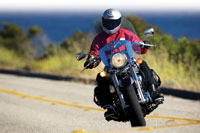
Climb aboard, and the view forward features a clean, brushed-look upper triple clamp, a very wide chromed handlebar on short risers and clean, chromed clamps. The unusually wide and tall windscreen does a fine job of protecting the rider’s torso, but likely does so at the expense of some wind drag and fuel mileage. It can be adjusted in height by about 2 inches, and at 6 feet tall I could just see over it in the down position. At about 65 mph and higher, the windscreen produces a lot of buffeting around the rider’s head. In the rider’s lap sprawls that chromed instrument nacelle with large analog speedometer (but no tachometer), a selection of warning lights and a fuel gauge. In our opinion the classic-look nacelle, which is similar to what Kawasaki has done in the past, is becoming a bit dated.
Our test bike carried the very attractive Metallic Ocean Blue/Metallic Phantom Silver paint combo that looks especially dressy and classy. While we loved the colors, certain aspects of the bike detract from what is otherwise an aspect of quality. Fenders are plastic, and the flange along the bottom of the fuel tank gives the bike that mass-produced look. We’re glad to see the radiator nestled between the frame downtubes, so it doesn’t protrude like the proverbial sore thumb. However, the frame tubes that flank it can be disassembled for engine access, and their nuts and bolts and members give them a cobbly look. Finally, the air cleaner cover is plastic and, unfortunately, looks like‚Ķwell, plastic. The LT is also available in Ebony/Candy Fire Red.
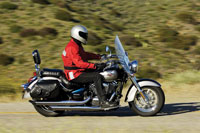
Sit down, stick out your left haunch, reach down and there’s the key in a very accessible location. Thanks to the digital electronic fuel injection with dual 34mm throttle bodies, this new Kawi cruiser lights off easily with no need for a manual choke or fast-idle control. A single-pin crankshaft gives the 900 Vulcan that coveted lope and rumble, which is muted thanks to its clean, slash-cut over/under exhausts. Of course a single-pin crank is notorious for inducing vibration, so Kawasaki has added a gear-driven counterbalancer along with rubber engine mounting to be certain that only enough of those vibes reach the rider to speak of “character” without screaming “vibration,” and they’ve done so very successfully.
Let out the clutch in first gear and the Vulcan takes off with a minimum of slippage, courtesy of its newfound torque. Thanks to the magic of fuel injection, it suffers none of the previous model’s cold-start problems. Our test bike’s injection was spot-on, and allowed for easy throttle control both on the road and at parking-lot speeds. The heel-and-toe shifter allows the Vulcan to shift among its five gears with little effort and but a light touch on the cable-actuated clutch.
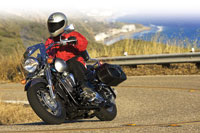
Thanks to EPA mandates the exhaust note is muted, but the LT’s standard windscreen reflects more of the sound to the rider and it’s a joyful noise. Especially at low rpm the sound is throaty and has just that right amount of rumble. The engine’s subtle vibrations are felt occasionally in the seat and grips, but there’s never enough to make you wish they’d go away.
With a 32-degree rake and 6.5 inches of trail, steering is deliberate and steady. This slow steering also helps contribute to the impression that this is a big motorcycle. The 41mm fork with its chromed covers offers no adjustments, but the typical cruiser rider won’t likely call for any. The single rear shock offers spring preload adjustment-there is no damping adjuster but the stock shock works well for a cruiser shock, and is a bit stiff on the compression damping and adequate on the rebound. You’ll want to crank in sufficient spring to help deal with those nasty bumps and lift the rear end, as once the Vulcan 900 is rolling in an entertaining manner you’ll lean ‘er over and soon have the floorboards clattering along the pavement. They provide plenty of warning of impending doom lest you push too far.
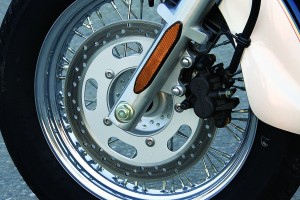
Nor will the rider have any worries about the brakes. Though there’s only a single 300mm disc up front with a two-piston caliper, it offers good braking force for this 659-pound motorcycle, and the lever has an adjustment wheel; the clutch lever does not. The rear brake is a single 270mm disc, and does an admirable job in concert with the front.
What distinguishes the LT version from the stripped model is its large, adjustable windscreen, cowhide saddlebags, special studded seat and passenger backrest. As for the seat, it has several pressure points and does not distribute the weight well, which makes it seem narrower and harder than it should be. Seat height is just 26.8 inches, which should accommodate the great majority of riders including those short of inseam. The passenger backrest is always a welcome addition to any motorcycle.
The matching studded saddlebags are cowhide, quite attractive, and offer quick-release (squeeze to open) nylon buckles hidden behind the traditional buckle. The bags measure 18 inches long by 6 inches wide and 8 deep, which is adequate but not huge. Internal metal reinforcements help them hold their shape, and the lids overlap the bodies to help keep out the weather.
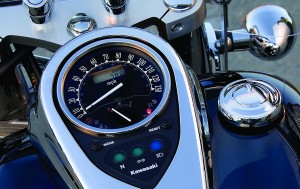
That shapely tank (OK, it’s got a flange) holds 5.3 gallons of fuel that, at the 44.6-mpg average I turned, should deliver a range of around 236 miles. While on the road, it seemed to me that the screen was pushing a lot of air, and that fuel economy would be improved if it were removed.
The more I rode, the more I got the impression that Kawasaki was performing a sleight of hand with the Vulcan 900. Its 64.8-inch wheelbase, broad tank and large fenders give it the appearance and seeming dimensions of a big bike. However, with its 903cc engine it has the performance of what is now classed as a midsizer, and above 70 mph its engine seems to begin straining. This is not necessarily a criticism, but more of an observation that the Vulcan sits and looks and feels like a brawler, but with its 659-pound wet weight and 903cc engine it doesn’t offer that heft and accelerative punch we’ve come to associate with the big-inch V-twins. But that’s OK, as at $8,499 it won’t deliver that nasty kick to your wallet, either.

If the price sounds to you like motorcycling’s equivalent of a good five-cent cigar, consider that the base model without the touring equipment is priced at a mere $7,299; what’s that, a four-cent cigar? And while you can certainly buy your own aftermarket screen, bags and seat for the difference, they won’t likely look as good as what’s on the LT. Then consider the 24-month warranty and it looks like it’s time to light up. If this is what eight-and-a-half big ones can buy, well, we expect the public will be smokin’!
If you’re interested in the 2006 Kawasaki Vulcan 900 Classic LT, you might also be interested in Rider‘s 2009 Kawasaki Vulcan 900 Custom SE and Classic LT Review, or our Middleweight comparo featuring the 2008 Kawasaki Vulcan 900 Classic LT as well as the Honda VTX1300T, Suzuki Boulevard C50T and Star V Star 1100 Silverado.







